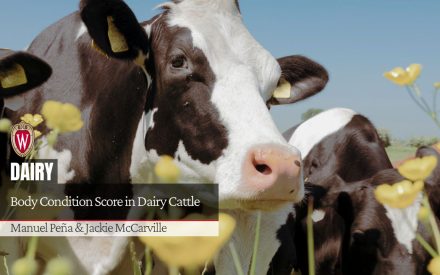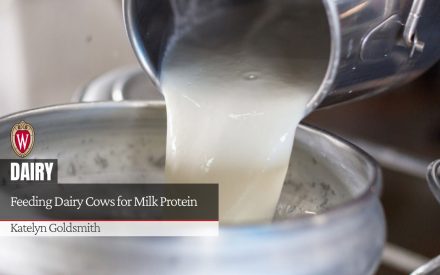This article was originally published in the Wisconsin Agriculturist
Something that is constantly on the mind of dairy producers, no matter how small or large the farm, is the cost of production. Feed is the largest input cost on the dairy, making efficiency with feed bunk management a priority for all dairy farm managers. Fortunately, there are several factors related to feeding and feed bunk management for consideration that can help lower the cost of production and keep more money in our pockets.
| Activity | Time devoted to activity per day |
| Eating | 3-5 hours |
| Lying/resting | 12-14 hours |
| Social interactions | 2-3 hours |
| Ruminating | 7-10 hours |
| Drinking | 30 minutes |
| Outside pen (milking, travel time) | 2.5-3.5 hours |
Eating time
When we look at the chart of a cow’s daily time budget, we can see how 24 hours are devoted in a cow’s life. When cows are denied access to feed, water, and stalls for greater than 3.5 hours/day, they are forced to give up on something else. Many times, that will end up being resting or eating time. Providing them access to these items helps with feed bunk management. Minimizing time spent outside the pen allows for more time spent on eating, resting, and ruminating.
Pushing up feed
One key of feed bunk management is making sure cows have fresh feed to eat when they are finished milking whether it be a TMR or silage at a bunk. Another benefit from cows going to fresh feed after milking is to get them to remain standing for thirty minutes after milking. This allows for the post-dip to dry and provides adequate time for the teat sphincter muscle to fully close which reduces the chances of an intermammary infection to occur. If adding an additional fresh feed out is impossible, pushing up feed that is already there can be a great benefit. Frequent pushing up of feed can help with increased dry matter intakes, fat-corrected milk yields, less feed refusal, and increasing the time spent standing after milking.
Refusals
Limiting refusals is also a great feed bunk management practice. Bunk management is a balancing act of not underfeeding, resulting in cows going without access to feed, and not over delivering feed resulting excessive feed refusals. Fresh cattle should have the greatest amount of refusals, in the 3-5% range, with high producers having around 1-5% and late lactation at 0.5-3%. For late lactation pens, a helpful hint to remember is their feed refusal rate should also be close to their dry matter intake rate. Keeping refusals in these ranges helps cut down input costs. Knowing how much cows are eating by tracking how much feed is delivered and weighing back refusals is critical in limiting the amount of refusals at the feed bunk. The goal is not to have an empty bunk for many hours before new feed is delivered but rather have cows clean up feed as close to 1% refusal as practical.
Having a plan on how to repurpose refusals can also help save some money. Of course, not all refusals are adequate to be refed to other animals. Feed that is hot, slimy, extremely stemmy or woody should just be disregarded. Never feed refusals to prefresh or fresh cows. Knowing the nutritional value of the refusals can help determine the best fit for repurposing these. Many times, they can go into a late lactation diet.
Time of year/weather
Another consideration when thinking about feed bunk management is the time of year. In the winter, cows typically eat more to fulfill their higher energy requirements. During the heat of summer, dry matter intakes drop, and we need to be careful that they don’t drop too much. It is especially important in the summer to keep fresh feed in front of the cows as it can quickly get heated and spoiled.
Resources
https://extension.psu.edu/milking-management-consistency-is-the-key
https://dairy.osu.edu/newsletter/buckeye-dairy-news/volume-19-issue-5/dairy-feed-bunk-management
https://extension.psu.edu/feed-bunk-management
http://wdmc.org/2009/Stocking%20Density%20&%20Time%20Budgets.pdf

 ▶️ Watch: Hay There! Let’s Talk Feed Centers and Inventory
▶️ Watch: Hay There! Let’s Talk Feed Centers and Inventory Body Condition Score in Dairy Cattle
Body Condition Score in Dairy Cattle ▶️ Watch: Prácticas de manejo para mejorar la calidad del forraje
▶️ Watch: Prácticas de manejo para mejorar la calidad del forraje Feeding Dairy Cows for Milk Protein
Feeding Dairy Cows for Milk Protein


